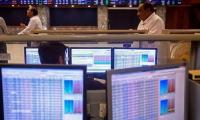With Donald Trump heading back to the White House, Wall Street is anticipating the potential for lower taxes, deregulation and a US president who is quick to sound off on everything from the stock market to the dollar.
Trump made tariffs and tax cuts key elements of his pitch to voters, many of whom said the economy was the biggest issue of the election. Another important plank of his platform is expected to be deregulation in areas ranging from the banking industry to cryptocurrencies.
The promise of those policies appears to have already stirred prices for some assets, including the dollar, shares of regional banks and the price of bitcoin.For a Trump administration, “markets are basically thinking it’s pro-growth, even if it comes with higher inflation and higher interest rates,” said David Bianco, Americas chief investment officer at DWS Group.
Edison Research projected on Wednesday that Trump had secured more than the 270 Electoral College votes needed to win the presidency.While political developments can move markets, investors say they typically tend to take a back seat to macroeconomic forces and the health of corporate profits as well as global events.
For example, the S&P 500 rose nearly 70 per cent during Trump’s first term as technology shares soared, even as his tariff policies sparked bouts of volatility. Meanwhile, the energy sector notched deep losses after global economies were paralyzed by the Covid-19 pandemic, although his administration was friendly to fossil fuel development.
HISTORY NOT A GUIDE?
Trump’s election in 2016 sparked a so-called reflation trade, with investors piling into an array of assets such as copper futures and shares of construction companies on the belief that tax cuts and other stimulative policies would boost sluggish US economic growth.
But the economic landscape has changed, and some investors believe the moves of 2016 may not offer an accurate roadmap for how stocks, bonds and the dollar might trade in coming months.
The US economy grew by an annualized rate of 2.8 per cent in the third quarter of 2024, compared to just below 2.0 per cent in 2016. And while months of restrictive monetary policy have helped tamp inflation down from four-decade highs hit in 2022, some investors worry tariffs or tax cuts could send consumer prices higher again. By contrast, sluggish inflation and growth were concerns for the Fed eight years ago.
Signs of rebounding inflation could also cause a rethink of the Federal Reserve’s interest rate trajectory, with the central bank just beginning to ease monetary policy after hiking rates to bring inflation down from 40-year highs.
And while the last weeks of the 2024 presidential race saw betting markets move in favour of Trump over his opponent, Kamala Harris, his 2016 victory “was a general surprise, the positive market reaction was a surprise too, and the investor positioning in the runup to elections was for a disinflationary backdrop,” JPMorgan strategists wrote on Monday.
TARIFFS AND TAX REFORM
The potential implementation of tariffs -- which Trump has vowed to increase by 10% on imports, and 60 per cent on goods from China -- could make a key difference in how investors approach asset markets in coming months.
A study by Deutsche Bank said a Trump victory would add about half a percentage point to US gross domestic product if tariffs are not implemented. Tariffs would subtract about a quarter of a point from GDP, the study found.
“There are still going to be some question marks as to how aggressive Trump does go with tariffs, and that’s going to be a story regardless of the composition of Congress, given that can be pushed through via executive action,” said Garrett Melson, portfolio strategist at Natixis Investment Managers.
Trump also wants tax reform, including reducing the corporate tax rate to 15 per cent, for those companies that make their products in the U.S., after having cut the rate to 21 per cent from 35 per cent during his 2017-2021 presidency.
Such tax cuts -- which will need to pass Congress -- could support company earnings and sentiment for stocks, although the extent of such a boost remains to be seen.Cutting the rate to 15 per cent would boost S&P 500 earnings by about 4%, according to estimates by Goldman Sachs strategists.
A representational image of the expo centre. —Facebook@PakistanExpoCentres/FileLAHORE: The Trade Development...
People wearing Omega watches can be seen. —Facebook@SonrajOfficial/FileKARACHI: Sonraj, a leading name in the...
Samsung logo can be seen. — Reuters/FileKARACHI: Sapphire Electronics Limited, a subsidiary of Reliance Cotton...
Image showing a view of Doha Forum. — X@DohaForum/FileThe Doha Forum, held from December 7-8, 2024, once again...
Electric power generating wind turbines and solar panels can be seen. — AFP/FileLAHORE: Global efforts to bolster...
A model of the natural gas pipeline is placed on Russian Rouble banknote and a flag in this illustration taken, March...







